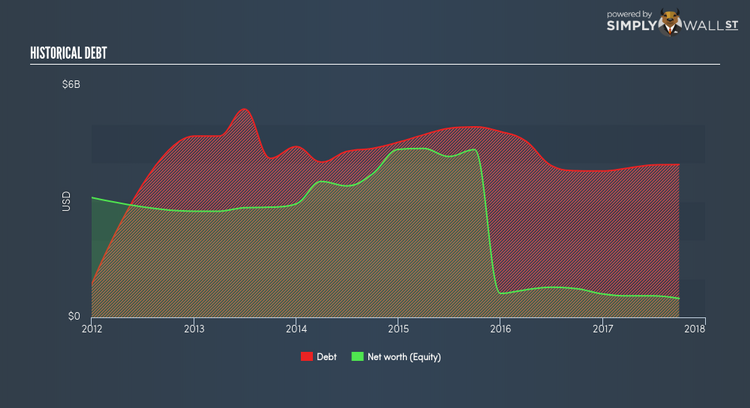Are EP Energy Corporation’s (NYSE:EPE) Interest Costs Too High?

While small-cap stocks, such as EP Energy Corporation (NYSE:EPE) with its market cap of $560.88M, are popular for their explosive growth, investors should also be aware of their balance sheet to judge whether the company can survive a downturn. Oil and Gas companies, especially ones that are currently loss-making, tend to be high risk. Evaluating financial health as part of your investment thesis is crucial. I believe these basic checks tell most of the story you need to know. Though, I know these factors are very high-level, so I’d encourage you to dig deeper yourself into EPE here.
How does EPE’s operating cash flow stack up against its debt?
EPE’s debt levels have fallen from $4,812.0M to $3,789.0M over the last 12 months , which is made up of current and long term debt. With this debt repayment, the current cash and short-term investment levels stands at $20.0M , ready to deploy into the business. Moreover, EPE has produced cash from operations of $784.0M over the same time period, leading to an operating cash to total debt ratio of 20.69%, signalling that EPE’s operating cash is sufficient to cover its debt. This ratio can also be interpreted as a measure of efficiency for unprofitable businesses since metrics such as return on asset (ROA) requires positive earnings. In EPE’s case, it is able to generate 0.21x cash from its debt capital.
Can EPE pay its short-term liabilities?
At the current liabilities level of $321.0M liabilities, the company is not able to meet these obligations given the level of current assets of $248.0M, with a current ratio of 0.77x below the prudent level of 3x.
Can EPE service its debt comfortably?
With total debt exceeding equities, EPE is considered a highly levered company. This is not uncommon for a small-cap company given that debt tends to be lower-cost and at times, more accessible. Though, since EPE is currently loss-making, there’s a question of sustainability of its current operations. Running high debt, while not yet making money, can be risky in unexpected downturns as liquidity may dry up, making it hard to operate.
Next Steps:
EPE’s high debt levels is not met with high cash flow coverage. This leaves room for improvement in terms of debt management and operational efficiency. In addition to this, the company may not be able to pay all of its upcoming liabilities from its current short-term assets. This is only a rough assessment of financial health, and I’m sure EPE has company-specific issues impacting its capital structure decisions. You should continue to research EP Energy to get a more holistic view of the stock by looking at:
1. Future Outlook: What are well-informed industry analysts predicting for EPE’s future growth? Take a look at our free research report of analyst consensus for EPE’s outlook.
2. Historical Performance: What has EPE’s returns been like over the past? Go into more detail in the past track record analysis and take a look at the free visual representations of our analysis for more clarity.
3. Other High-Performing Stocks: Are there other stocks that provide better prospects with proven track records? Explore our free list of these great stocks here.
To help readers see pass the short term volatility of the financial market, we aim to bring you a long-term focused research analysis purely driven by fundamental data. Note that our analysis does not factor in the latest price sensitive company announcements.
The author is an independent contributor and at the time of publication had no position in the stocks mentioned.

